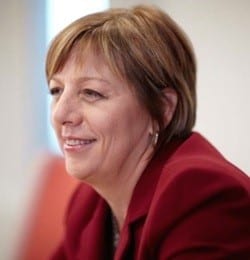
Canadian regulators are ahead of their peers in terms of examining market structure, especially high-frequency trading.
“I would draw attention to something that was posted by IIROC [this week], which is the second generation findings of their in-depth analysis of HFT in Canada,” said Robert Young, head of Liquidnet Canada. “There’s some really interesting stuff coming out of there. It’s interesting because we’re already ahead of the world and we’re keeping up our pace.”
The Investment Industry Regulatory Organization of Canada (IIROC) has posted on its website a presentation on the progress of its study on high-frequency trading.
Wendy Rudd, senior vice president of market regulation and policy at IIROC, speaking at Markets Media’s Canadian Trading and Investing Summit on April 17, said that the first regulatory objective is to ferret out market orders that were entered without an intent to trade.

Wendy Rudd, IIROC
The first regulatory priority is to stop illegal market activity, said Kevan Cowan, president, TSX Markets and group head of equities, TMX Group, also speaking at CTIS. If market activity is legal, it should be conducted with perfect transparency and subject to public debate, he said.
IIROC published the results of Phases 1 and 2 of its study in December 2012. The “HOT Study”, as it was called, relied on a methodology using a High Order-to-Trade ratio as the sole measure; this resulted in a very broad definition.
Since publication of the study, the research team has been exploring other approaches to identifying HFT activity, according to the presentation by Victoria Pinnington, vice president, Trading Review and Analysis at IIROC.
Several steps are involved in the new methodology, said Pinnington. First, the team filtered out User IDs with minimal orders or trades. Then it applied three measures to the remaining universe of IDs: order-to-trade ratio (still a factor); fast order amendment speed; and number of orders entered.
As with the HOT Study, this methodology captures certain types of activity in the marketplace regardless of source. “As a result, it will capture any type of market participants using HFT-like strategies, be they proprietary HFT firms, or dealers and clients using strategies that are HFT-like,” said Pinnington. “Going forward, we will continue to refine our identification of HFT.”
Most metrics show slightly less HFT activity when compared to HOT. “In general, we do not see a reduction in the percentage of trades executed by HFT when compared to HOT; in fact there is a slight increase in the percentage of trades in TSX-listed securities,” said Pinnington. “We see a more dramatic decrease in the percentage of order activity by HFT (vs. HOT) which we believe may partially result from our change in methodology. So IIROC is leaving the HOT methodology behind us.”
The publication of Flash Boys by Michael Lewis has stoked the debate over high-frequency trading. While the book has a decidedly anti-HFT slant, going so far as to suggest that the markets are rigged in favor of HFTs, at least one Canadian market structure expert has taken exception.
Andriy Shkilko, a professor at the School of Business and Economics at Wilfrid Laurier University and holder of the Canada Research Chair in Financial Market, cited research showing that HFT makes markets more efficient by pushing stock prices in the right direction, allowing investors to buy and sell assets at correct valuations.
“Liquidity is the life blood of any market, and the presence of high frequency traders buying and selling massive volumes of stock in the blink of an eye inevitably makes markets more liquid,” he said in a blog posting. “This means when HFT goes up, trading costs go down.”
Featured image via Mymandesigns/Dollar Photo Club




